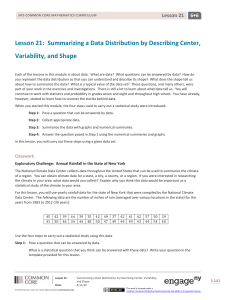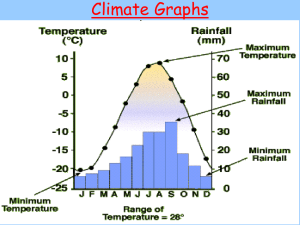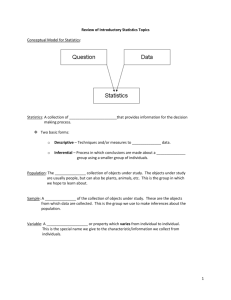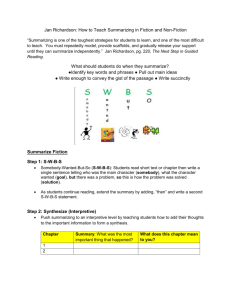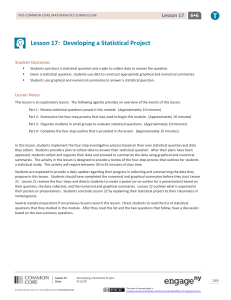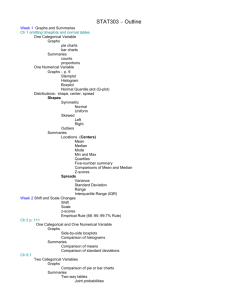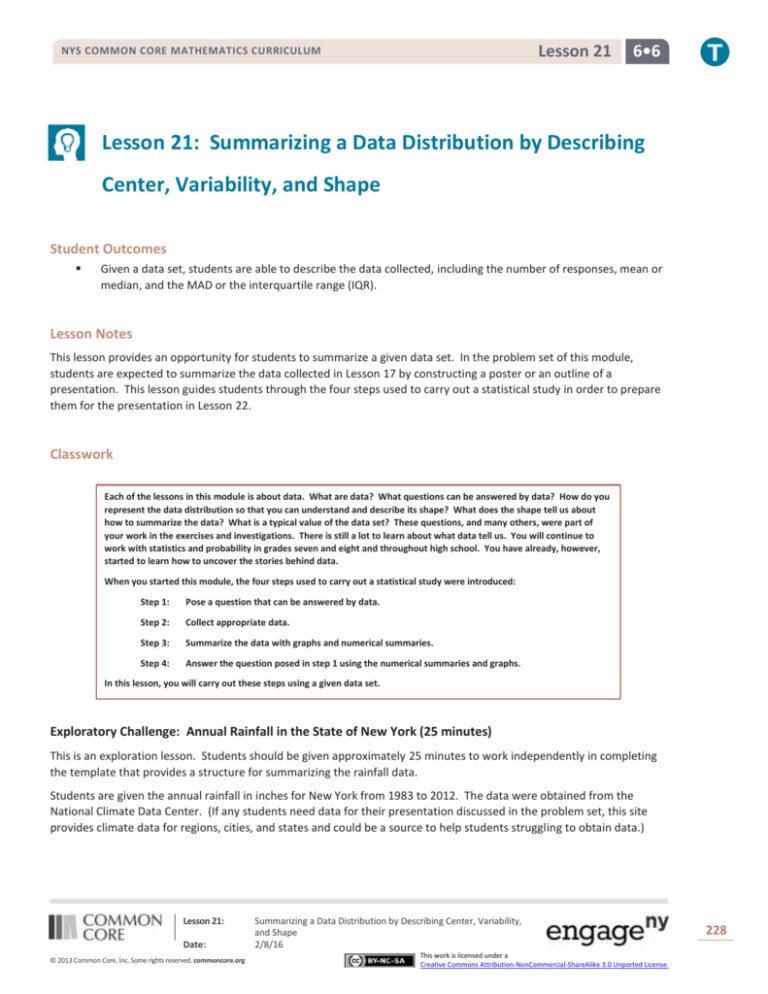
Lesson 21
NYS COMMON CORE MATHEMATICS CURRICULUM
6•6
Lesson 21: Summarizing a Data Distribution by Describing
Center, Variability, and Shape
Student Outcomes
Given a data set, students are able to describe the data collected, including the number of responses, mean or
median, and the MAD or the interquartile range (IQR).
Lesson Notes
This lesson provides an opportunity for students to summarize a given data set. In the problem set of this module,
students are expected to summarize the data collected in Lesson 17 by constructing a poster or an outline of a
presentation. This lesson guides students through the four steps used to carry out a statistical study in order to prepare
them for the presentation in Lesson 22.
Classwork
Each of the lessons in this module is about data. What are data? What questions can be answered by data? How do you
represent the data distribution so that you can understand and describe its shape? What does the shape tell us about
how to summarize the data? What is a typical value of the data set? These questions, and many others, were part of
your work in the exercises and investigations. There is still a lot to learn about what data tell us. You will continue to
work with statistics and probability in grades seven and eight and throughout high school. You have already, however,
started to learn how to uncover the stories behind data.
When you started this module, the four steps used to carry out a statistical study were introduced:
Step 1:
Pose a question that can be answered by data.
Step 2:
Collect appropriate data.
Step 3:
Summarize the data with graphs and numerical summaries.
Step 4:
Answer the question posed in step 1 using the numerical summaries and graphs.
In this lesson, you will carry out these steps using a given data set.
Exploratory Challenge: Annual Rainfall in the State of New York (25 minutes)
This is an exploration lesson. Students should be given approximately 25 minutes to work independently in completing
the template that provides a structure for summarizing the rainfall data.
Students are given the annual rainfall in inches for New York from 1983 to 2012. The data were obtained from the
National Climate Data Center. (If any students need data for their presentation discussed in the problem set, this site
provides climate data for regions, cities, and states and could be a source to help students struggling to obtain data.)
Lesson 21:
Date:
© 2013 Common Core, Inc. Some rights reserved. commoncore.org
Summarizing a Data Distribution by Describing Center, Variability,
and Shape
2/8/16
This work is licensed under a
Creative Commons Attribution-NonCommercial-ShareAlike 3.0 Unported License.
228
Lesson 21
NYS COMMON CORE MATHEMATICS CURRICULUM
6•6
Before students organize their summary, discuss the context explained in the lesson. Make sure the students
understand what the data represent by highlighting the words annual and rainfall. Ask students to guess a value that
they think represents the typical rainfall for New York in a year. Record these guesses and refer to them after students
have summarized this data set and calculated a measure of center. Also, ask students why a statistical study of rainfall is
important. For example, when a reporter says that a certain year was unusually rainy, on what basis was that claim
made?
Direct students to study the template that is included with this lesson. Review the four steps involved in a statistical
study. Indicate that during the next 25 minutes they are expected to complete the template that organizes their
statistical summary of the data.
Exploratory Challenge: Annual Rainfall in the State of New York
The National Climate Data Center collects data throughout the United States that can be used to summarize the climate
of a region. You can obtain climate data for a state, a city, a county, or a region. If you were interested in researching the
climate in your area, what data would you collect? Explain why you think this data would be important as a statistical
study of the climate in your area.
For this lesson, you will use yearly rainfall data for the state of New York that were compiled by the National Climate Data
Center. The following data are the number of inches of rain (averaged over various locations in the state) for the years
from 1983 to 2012 (𝟑𝟎 years).
𝟒𝟓
𝟒𝟏
𝟒𝟐
𝟑𝟖
𝟑𝟗
𝟒𝟔
𝟒𝟒
𝟑𝟒
𝟑𝟗
𝟒𝟒
𝟑𝟓
𝟒𝟖
𝟒𝟐
𝟓𝟎
𝟒𝟗
𝟒𝟕
𝟑𝟕
𝟒𝟗
𝟒𝟐
𝟒𝟒
𝟒𝟏
𝟒𝟗
𝟒𝟐
𝟒𝟑
𝟑𝟕
𝟒𝟒
𝟓𝟎
𝟓𝟒
𝟑𝟗
𝟒𝟎
Use the four steps to carry out a statistical study using this data.
Step 1:
Pose a question that can be answered by data.
What is a statistical question that you think can be answered with these data? Write your question in
the template provided for this lesson.
Step 2:
Collect appropriate data.
The data have already been collected for this lesson. How do you think these data were collected?
Recall that the data are the number of inches of rain (averaged over various locations in the state) for
the years from 1983 to 2012 (𝟑𝟎 years). Write a summary of how you think the data were collected in
the template for this lesson.
Step 3:
Summarize the data with graphs and numerical summaries.
A good first step might be to summarize the data with a dot plot. What other graph might you
construct? Construct a dot plot or another appropriate graph in the template for this lesson.
What numerical summaries will you calculate? What measure of center will you use to describe a
typical value for these data? What measure of variability will you calculate and use to summarize the
spread of the data? Calculate the numerical summaries and write them in the template for this
lesson.
Step 4:
Answer your statistical question using the numerical summaries and graphs.
Write a summary that answers the question you posed in the template for this lesson.
Lesson 21:
Date:
© 2013 Common Core, Inc. Some rights reserved. commoncore.org
Summarizing a Data Distribution by Describing Center, Variability,
and Shape
2/8/16
This work is licensed under a
Creative Commons Attribution-NonCommercial-ShareAlike 3.0 Unported License.
229
Lesson 21
NYS COMMON CORE MATHEMATICS CURRICULUM
6•6
The following directions should be considered as students develop a statistical summary of this data. Work with
students individually or in small groups as they complete the template.
Step 1: Pose a question that can be answered by data.
It is important that students are reminded of the two most important parts of the definition of a statistical question. A
statistical question is (1) a question that is answered by data, and (2) a question that anticipates the data will vary. As
students examine the data, point out to them that there is variability. Although students may vary the wording of their
questions, it is anticipated most students will form a question that essentially asks, “What is the typical annual rainfall in
New York?”
Step 2: How do you think the data were collected?
The data are given to students in this lesson. This step will be more challenging as they carry out their own statistical
study because they need to explain the plan they developed to collect their data. For this lesson, allow students to
speculate on how the National Climate Data Center probably collected this data. As the data represent the annual
rainfall for the state of New York, the Center had to collect rainfall totals from several reporting weather centers around
the state. They calculated an average of those levels for each day of the year. At the end of the year, the National
Climate Data Center averaged those daily results. Students might be asked how a rainfall level is measured at a weather
center. A rain gauge might be a good visual to share with students.
MP.4 Step 3: Construct graphs and calculate numerical summaries of the data.
This step represents most of the work students will be expected to do in this lesson. As a first step, encourage students
who are not sure how to start summarizing the data to construct a dot plot. A blank grid is provided at the end of the
Teacher Notes that can be duplicated for students who may need some structure in making a dot plot. This grid could
also be used if any student decides to develop a box plot or a histogram of the data distribution.
Dot plot of annual rainfall from 1983 to 2012
Students examine the dot plot and make decisions about the data distribution. For example, is the distribution
approximately symmetric or is the distribution skewed? This dot plot shows a data distribution that is approximately
symmetric.
Based on the decision that the distribution is approximately symmetric, students should proceed to calculate the mean
as a measure of center and the MAD as a measure of variability. Some students might also choose to investigate this
distribution with a box plot to answer the question about the symmetry.
Lesson 21:
Date:
© 2013 Common Core, Inc. Some rights reserved. commoncore.org
Summarizing a Data Distribution by Describing Center, Variability,
and Shape
2/8/16
This work is licensed under a
Creative Commons Attribution-NonCommercial-ShareAlike 3.0 Unported License.
230
Lesson 21
NYS COMMON CORE MATHEMATICS CURRICULUM
6•6
Box plot of annual rainfall from 1983 to 2012
The box plot does not indicate a perfectly symmetrical distribution; however, it is approximately symmetric. The mean
and the median of this data distribution are nearly equal to each other. Based on this decision, students should calculate
the mean and the MAD.
The mean rainfall is 43 inches (to the nearest inch), and the mean absolute deviation (MAD) is 3.9 or 4 inches (to the
nearest inch).
At the end of the Teacher Notes is a table that could be used for students who need structure in calculating the MAD.
There are several steps in calculating the MAD that might need to be organized for some students.
Step 4: Answer your statistical question using the numerical summaries and graphs.
MP.3
This step asks students to write a short summary interpreting the graphs and numerical summaries. Students should
connect this back to their statistical question. Students would indicate that the typical rainfall for New York is 43 inches
per year. They would also indicate that a typical deviation from the mean is about 4 inches.
Template for Lesson 21
Step 1: What is your statistical question?
Step 2: How do you think the data were collected?
Step 3: Construct graphs and calculate numerical summaries of the data.
Construct at least one graph of the data distribution. Calculate appropriate numerical summaries of the data.
Also indicate why you selected these summaries.
Step 4: Answer your statistical question using your graphs and numerical summaries.
Lesson 21:
Date:
© 2013 Common Core, Inc. Some rights reserved. commoncore.org
Summarizing a Data Distribution by Describing Center, Variability,
and Shape
2/8/16
This work is licensed under a
Creative Commons Attribution-NonCommercial-ShareAlike 3.0 Unported License.
231
Lesson 21
NYS COMMON CORE MATHEMATICS CURRICULUM
6•6
Closing (5 minutes)
If time permits, look at the original guesses students made to this question. Did students have a pretty good idea of the
annual rainfall in New York? Discuss this question with students.
Lesson Summary
Statistics is about using data to answer questions. The four steps used to carry out a statistical study include posing
a question that can be answered by data, collecting appropriate data, summarizing the data with graphs and
numerical summaries, and using the data, graphs, and summaries to answer the statistical question.
Exit Ticket
Consider a special type of Exit Ticket for this lesson. As students are expected to complete a summary of the four-step
investigative study, use this opportunity to assess your students’ understanding of this process as related to the question
they formed and the data they collected. The Exit Ticket for this lesson is to complete the following direction (state this
direction to the students):
Based on your current preparation, summarize the four steps you are expected to complete as part of presenting a
statistical study.
Lesson 21:
Date:
© 2013 Common Core, Inc. Some rights reserved. commoncore.org
Summarizing a Data Distribution by Describing Center, Variability,
and Shape
2/8/16
This work is licensed under a
Creative Commons Attribution-NonCommercial-ShareAlike 3.0 Unported License.
232
Lesson 21
NYS COMMON CORE MATHEMATICS CURRICULUM
Name ___________________________________________________
6•6
Date____________________
Lesson 21: Summarizing a Data Distribution by Describing Center,
Variability, and Shape
Exit Ticket
Based on your current preparation, summarize the four steps you are expected to complete as part of presenting a
statistical study.
Lesson 21:
Date:
© 2013 Common Core, Inc. Some rights reserved. commoncore.org
Summarizing a Data Distribution by Describing Center, Variability,
and Shape
2/8/16
This work is licensed under a
Creative Commons Attribution-NonCommercial-ShareAlike 3.0 Unported License.
233
Lesson 21
NYS COMMON CORE MATHEMATICS CURRICULUM
6•6
Exit Ticket Sample Solutions
Based on your current preparation, summarize the four steps you are expected to complete as part of presenting a
statistical study.
Step 1: State my statistical question. My question is based on collecting data that will vary.
Step 2: Devise a plan to collect data. I prepared a question to ask the students in my class. (Allow students to explain
the question they asked, the responses they received, and the method they used for recording answers.)
Step 3: Summarize my data. I prepared a dot plot of the responses to the question. My dot plot indicated that the
responses to my question were skewed to the left; therefore, I used the median of the data distribution to
describe my center and the IQR to describe the variability. (Allow for a summary of the specific median or mean,
and a specific summary of the variability as the MAD or IQR.)
Step 4: Based on my graphs and numerical summaries, I answered my question.
Problem Set Sample Solutions
The problem set for this lesson involves creating a poster or an outline for a presentation using the data collected in
Lesson 17. The directions in the lesson indicate that students are expected to carry out the four steps either on their
poster or outlined for a presentation. If students provided an adequate summary of the four-step process in the exit
ticket, they could use their summary as a guide in completing the poster. Highlight the following with students:
For Step 1, students are expected to have a question clearly identified as their statistical question. The question should
involve the data they collected. Students should have anticipated variability in the data.
For Step 2, students should indicate how they collected the data based on the plan proposed in Lesson 17. For example,
for a question that investigates a typical height of students in the class, did every student state his or her height in inches
or was there a way to measure everyone’s height? For a question that investigates how many books students read, did
students ask members of their class how many books they read each month?
For Step 3, students include graphs and numerical summaries of the data. (Again, if students need more structure in
constructing their graphs, provide them with the coordinate grids for this lesson.) It is anticipated that students begin
with a dot plot. From the dot plot, students might construct a box plot or a histogram. Based on the shape of the
distribution, students select appropriate numerical summaries--either the mean and the mean absolute deviation (MAD)
or the median and the interquartile range (IQR). Posters or outlines should indicate what summaries were used and
why.
For Step 4, students should have a concluding statement that answers the statistical question. Students should provide
a brief description of their numerical summaries and graphs.
In Lesson 17, you posed a statistical question and a plan to collect data to answer your question. You also constructed
graphs and calculated numerical summaries of your data. Review the data collected and your summaries.
Based on directions from your teacher, create a poster or an outline for a presentation using your own data. On your
poster, indicate your statistical question. Also, indicate a brief summary of how you collected your data based on the
plan you proposed in Lesson 17. Include a graph that shows the shape of your data distribution, along with summary
measures of center and variability. Finally, answer your statistical question based on the graphs and the numerical
summaries.
Share the poster you will present in Lesson 22 with your teacher. If you are instructed to prepare an outline of the
presentation, share your outline with your teacher.
Lesson 21:
Date:
© 2013 Common Core, Inc. Some rights reserved. commoncore.org
Summarizing a Data Distribution by Describing Center, Variability,
and Shape
2/8/16
This work is licensed under a
Creative Commons Attribution-NonCommercial-ShareAlike 3.0 Unported License.
234
Lesson 21
NYS COMMON CORE MATHEMATICS CURRICULUM
6•6
Additional Resource Materials
The following could be used to provide structure in constructing a dot plot, histogram, or box plot of the rainfall data. A
similar type of grid (or graph paper) could be prepared for students as they complete the problem set. The grid provided
for students should not include the units along the horizontal axis as that is part of what they are expected to do in
preparing their summaries.
Lesson 21:
Date:
© 2013 Common Core, Inc. Some rights reserved. commoncore.org
Summarizing a Data Distribution by Describing Center, Variability,
and Shape
2/8/16
This work is licensed under a
Creative Commons Attribution-NonCommercial-ShareAlike 3.0 Unported License.
235
Lesson 21
NYS COMMON CORE MATHEMATICS CURRICULUM
6•6
The following table could be used for students requiring some structure in calculating the mean absolute deviation, or
MAD:
Data Value
Mean
Data Value – Mean
Absolute Value of
Data Value – Mean
45
42
39
44
39
35
42
49
37
42
41
42
37
50
39
41
38
46
34
44
48
50
47
49
44
49
43
44
54
40
Lesson 21:
Date:
© 2013 Common Core, Inc. Some rights reserved. commoncore.org
Summarizing a Data Distribution by Describing Center, Variability,
and Shape
2/8/16
This work is licensed under a
Creative Commons Attribution-NonCommercial-ShareAlike 3.0 Unported License.
236

